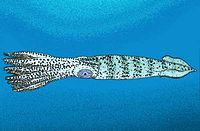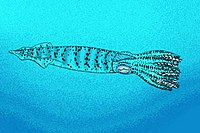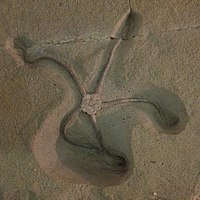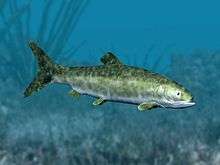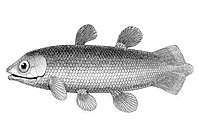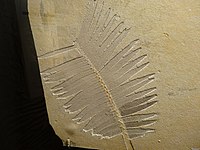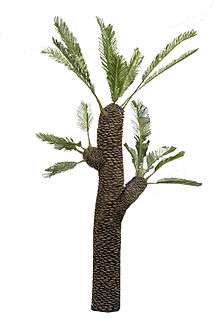Moltrasio Formation
The Moltrasio Formation also known as Lombardische Kieselkalk Formation is a geological formation in Italy. This Formation mostly developed on the Lower ot Middle Sinemurian stage of the Lower Jurassic, where on the Lombardian basin tectonic activity modified the current marine and terrestrial habitats.[2] Here it was developed a series of marine-related depositional settings, represented by an outcrop of 550–600 m of grey Calcarenites and Calcilutites with chert lenses and marly interbeds, that recovers the Sedrina, Moltrasio and Domaro Formations.[2] This was mostly due to the post-Triassic crisis, that was linked locally to tectonics.[3] The Moltrasio Formation is considered a continuation of the Sedrina Limestone and the Hettangian Albenza Formation, and was probably a shallow water succession, developed on the pasive margin of the westernmost Southern Alps.[3][4] It is known due to the exquisite preservation observed on the Outcrop on Osteno, where several kinds of marine biota have been recovered.[5]
| Moltrasio Formation Stratigraphic range: Early-Middle Sinemurian ~199–194 Ma | |
|---|---|
Outcrop | |
| Type | Geological formation |
| Unit of | Monte Generoso Basin |
| Sub-units | Osteno Outcrop |
| Underlies | Domaro Formation |
| Overlies | Sedrina Limestone |
| Lithology | |
| Primary | Limestone |
| Location | |
| Coordinates | 46.0°N 9.1°E |
| Approximate paleocoordinates | 33.2°N 15.6°E |
| Region | Lombardy |
| Country | |
| Type section | |
| Named for | Moltrasio |
| Named by | Antonio Stoppani[1] |
| Year defined | 1857 |
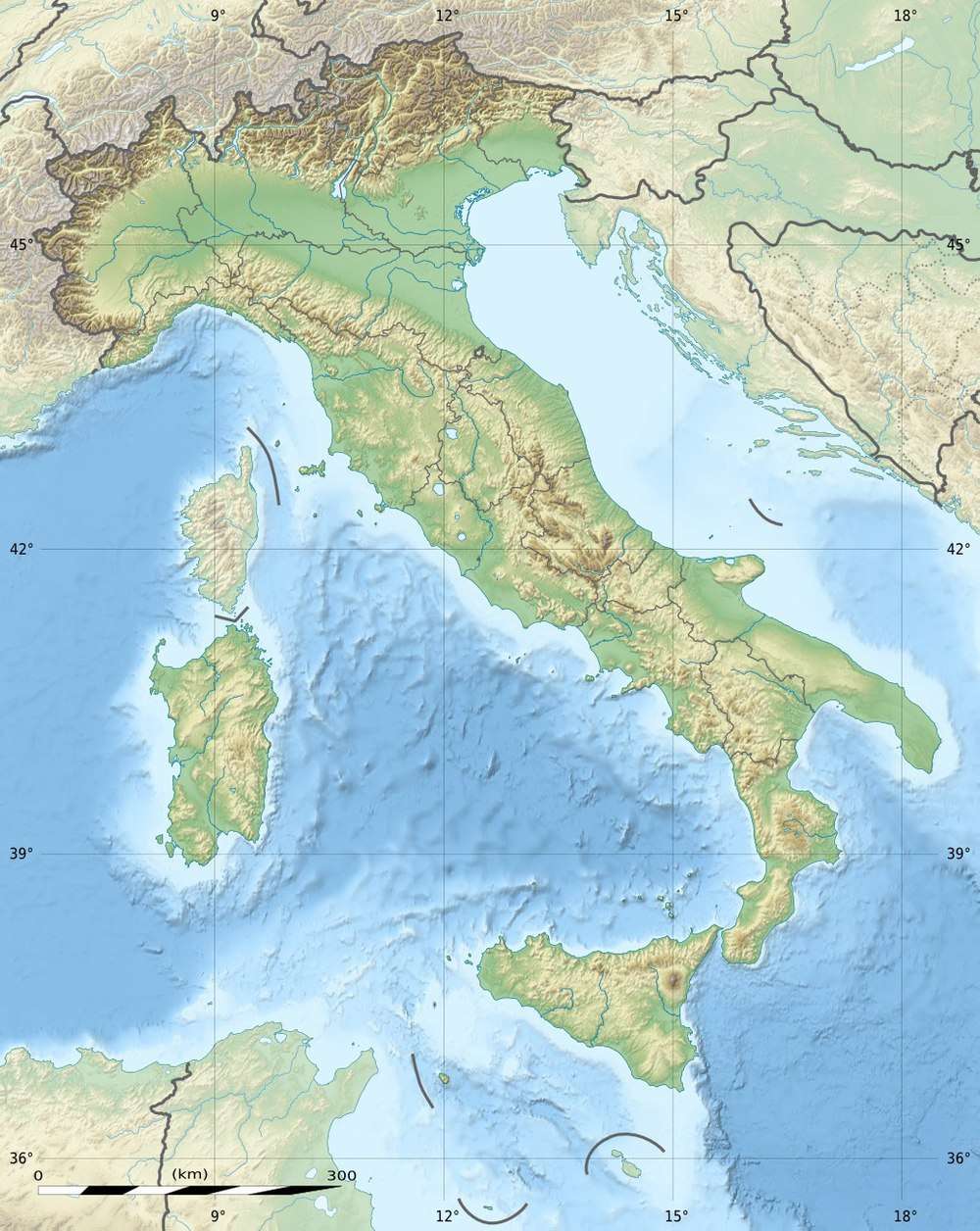 Moltrasio Formation (Italy) 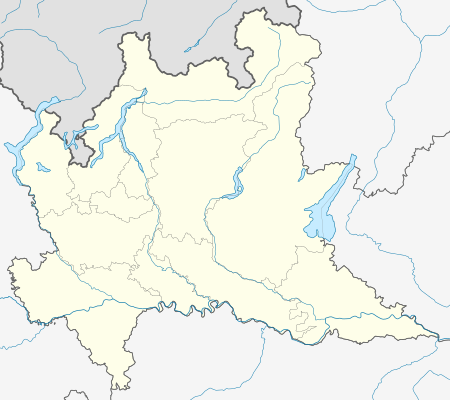 Moltrasio Formation (Lombardy) | |
Fossils
Exceptional fossilization
Apart from the Eocene of Monte Bolca, the Sinemurian of Osteno is the only fossil deposit in Italy in which soft bodies are preserved. Osteno site was discovered in 1964. It was recovered from a series of 6 metres (20 ft) package of fine laminated, gray, spongiolitic, micritic limestone.[6] Coroniceras bisulcatum allowed to date the outcrop as the Bucklandi zone, lower Sinemurian.[6] The outcrop is a good documentation of a particularly complete fauna and flora of the Lower Jurassic which is not exactly common in the Southern Alps.[6] The Osteno outcrop, part of the formation, is worldwide known due to the exceptional preservation of mostly marine biota, including rare fossilized components, helping to understand the ecosystems of the local Sinemurian margin of the Monte Generoso Basin.[7] The high local variety of fossils found can be due to unique conditions of preservation, where phosphatized soft tissues have not been observed in any fish or polychaetes, but they are common in crustaceans (33%) and also occur in a smaller percentage of teuthids (14%).[8] Soft part preservation through phosphatization in this deposit includes the muscles and branchia of Crustaceans, fish tissues, and the digestive tracts of Coleoids, Polychaetes, and Nematodes. These fossils are interpreted as having been preserved in a stagnant, restricted basing with anoxic conditions likely within the sediment pore waters.[5]
Nematoida
| Genus | Species | Material | Location | Notes | Images |
|---|---|---|---|---|---|
|
Eophasma jurasicum |
|
Osteno Outcrop.[9] |
A Nematode, type member of the family Eophasmidae inside Desmoscolecida.[10] A rare find, since most of the Nematodes fossils are absent on the Mesozoic marine rocks.[9] |
| |
Annelida
| Genus | Species | Material | Location | Notes | Images |
|---|---|---|---|---|---|
|
Melanoraphia maculata |
|
Osteno Outcrop.[11] |
A Polychaetan, member of the family Phyllodocemorpha with Incertade Sedis assignation. This polychaete was probably an open swimmer more that a subtrate dweller.[11] |
| |
Crustacea
| Genus | Species | Material | Location | Notes | Images |
|---|---|---|---|---|---|
|
|
Osteno Outcrop.[13] |
A Decapodan, type member of the family Aegeridae. This genus is the most abundant local Crustacean, Shrimp-like creature that was probably necrophagous.[13] |
| |
|
|
Osteno Outcrop.[13] |
A Decapodan, type member of the family Coleiidae. Probably a bottom dweller predatory crustacean.[14] |
| |
|
|
Osteno Outcrop.[13] |
A Decapodan, member of the family Litogastroidae. Probably a bottom dweller predatory crustacean.[14] |
||
|
|
Osteno Outcrop.[13] |
A Decapodan, member of the family Mecochiridae. Rather rare than other local crustacean genera. |
||
|
|
Osteno Outcrop.[13] |
A Decapodan, member of the family Erymidae. Was included on the genus Eryma as E. meyeri. Altrougth the specimens reveal morphological characters diagnostic of Palaeastacus.[18] |
||
|
|
Osteno Outcrop.[13] |
A Decapodan, type member of the family Erymidae. Was identified as Pustulina sinemuriana.[18] |
||
Thylacocephala
| Genus | Species | Material | Location | Notes | Images |
|---|---|---|---|---|---|
|
Ostenocaris cypriformis |
|
Osteno Outcrop.[20] |
A Thylacocephalan, type member of the family Ostenocarididae inside Conchyliocarida.[22] Originally Interpreted as a bizarre Cirriped.[23] Ostenocaris is the most know fossil of the Formation, and the main identified Thylacocephalan from the layers. On the first interpretations, the genus was showed as a filter-feeding organism, which used the cephalic sac as a burrowing organ to ensure adhesion to the substrate.[23] Based on the presence of Coprolites associated to the genus, with abundant masses of alimentary residues (hooks of cephalopods, vertebres, remains of Crustacea) in the stomach of these organisms le to modify the previous interpretation. Ostenocaris cypriformis was probably a necrophagous organism, and the cephalic sac can be tentatively interpreted as being a burrowing organ employed during the search for food, or as an organ of locomotion with intrinsic motility.[24] |
| |
Cefalophoda
| Genus | Species | Material | Location | Notes | Images |
|---|---|---|---|---|---|
|
|
An Ammonitidan, type member of the family Arietitidae inside Psiloceratoidea.The main Ammonite identified locally. |
|||
|
|
An Ammonitidan, member of the family Arietitidae inside Psiloceratoidea. Less common than other Ammonites, altrougth index for some locations. |
|||
|
|
An Ammonitidan, type member of the family Oxynoticeratidae inside Ammonitida. Not the most abundant, but rather common. |
|||
|
|
An Ammonitidan, member of the family Schlotheimiidae inside Psiloceratoidea. Not the most abundant, but rather common. |
|||
|
|
An Ammonitidan, member of the family Lytoceratidae inside Lytoceratina. Not the most abundant, but rather common. |
|||
|
|
An Coleoidan, type member of the family Ostenoteuthidae. A unique group o coeloids, only found o this location. Coleoids with ten arms each bearing pairs of hooks, Ostenoteuthis measure between 18-30 cm length.[26] |
| ||
|
|
An Coleoidan, member of the family Ostenoteuthidae. A unique group o coeloids, only found o this location.[26] |
| ||
Echinoderms
| Genus | Species | Material | Location | Notes | Images |
|---|---|---|---|---|---|
|
|
Mount Campo dei Fiori.[6] |
An Ophiuridan, member of the family Ophiodermatidae inside Ophiodermatina. Extant tropical species like Ophioderma are benthic predators and scavengers that show the same short spines seen in Palaeocoma.[6] |
| |
Hemichordata
| Genus | Species | Material | Location | Notes | Images |
|---|---|---|---|---|---|
|
Megaderaion[27] |
Megaderaion sinemuriense |
|
Osteno Outcrop.[27] |
An Acorn worm, member of the family Harrimaniidae inside Harrimaniidae. It was a large sized member of its family. This genus probably lived linked to sand bottoms, where it made burrows to hide and find food.[27] |
|
Chondrichthyes
| Genus | Species | Material | Location | Notes | Images |
|---|---|---|---|---|---|
|
Ostenoselache stenosoma |
|
Osteno Outcrop.[28] |
An Eusclachiian, type member of the family Ostenoselachidae inside Elasmobranchii. A unique genus of Shark, only found on the Osteno Formation. With an englongated eel-Shaped Morphology, the specimens found measure at least 240 mm in length, with a neurocranium is with a long, complex rostrum.[28] Is other of the famous fossils found on the formation, as has been suggested it was an animal able to produce electric shocks, probably to kill prey.[28] |
| |
|
Squaloraja polyspondyla |
|
Osteno Outcrop.[28] |
A Chimaerid, type member of the family Squalorajidae inside Squalorajoidei. This genus belong to a lineage of Ray-like Chimaeras. |
| |
|
Palaeospinax pinnai |
|
Osteno Outcrop.[28] |
A Shark, type member of the family Paleospinacidae inside Synechodontiformes. Open water swimmer. |
||
Actinopterygii
| Genus | Species | Material | Location | Notes | Images |
|---|---|---|---|---|---|
|
Cosmolepis ornatus |
|
Osteno Outcrop.[31] |
A primitive Actinopterygiian, member of the family Palaeonisciformes. A late surviving representative of the family. |
||
|
Pteroniscus sp. |
|
Osteno Outcrop.[31] |
A primitive Actinopterygiian, member of the family Palaeonisciformes. A complicated genus, whose modern status is rather dubious. |
||
|
Peripeltopleurus sp. |
|
Osteno Outcrop.[31] |
A primitive Actinopterygiian, member of the family Peltopleuridae inside Neopterygii. A genus related with the Epicontinental deposition |
||
|
Dapedium sp. |
|
Osteno Outcrop.[31] |
A primitive Actinopterygiian, type member of the family Dapediidae inside Holostei. Probably a Coral Environment wanderer. |
||
|
Furo sp. |
|
Osteno Outcrop.[31] |
A primitive Actinopterygiian, type member of the family Furidae inside Ionoscopiformes. Open water swimmer, probably forming Schools. |
||
|
Pholidophorus bechei |
|
Osteno Outcrop.[31] |
A primitive Actinopterygiian, type member of the family Pholidophoridae inside Teleostei. Open water swimmer, probably forming Schools. It is the main fish recovered on the formation. |
| |
|
Pholidolepis sp. |
|
Osteno Outcrop.[31] |
A primitive Actinopterygiian, member of the family Pholidophoridae inside Teleostei. Open water swimmer, probably forming Schools. |
||
Sarcopterygii
| Genus | Species | Material | Location | Notes | Images |
|---|---|---|---|---|---|
|
Undina(Holophagus) cf. gulo |
|
Osteno Outcrop.[31] |
A Coelacanth, member of the family Latimeriidae inside Coelacanthiformes. Isolated scales of coelacanths analogous to the genus Holophagus are quite frequent on the Osteno deposits. A series of teeth can also belong to this genus. |
| |
Plants
| Genus | Species | Material | Location | Notes | Images |
|---|---|---|---|---|---|
|
Equisitites bunburyanus |
|
Osteno Outcrop.[31] |
A Horsetail, member of the family Equisetaceae inside Equisetales. A Freswater-related plant, that grew as fast as modern baboo on tropical settings. |
||
|
Pachypteris cf. rhomboidalis |
|
Osteno Outcrop.[31] |
A Tree Fern, member of the family Umkomasiaceae inside Peltaspermales. Fronds of large Tree Ferns, related to humid ecosystems. |
||
|
Otozamites bunburyanus |
|
Osteno Outcrop.[31] |
A Tree Spermatopsidan, member of the family Bennettitales inside Bennettitopsida. Cycad-like flora, common on dry settings. |
||
|
Zamites sp. |
|
Osteno Outcrop.[31] |
A Tree Spermatopsidan, member of the family Bennettitales inside Bennettitopsida. Cycad-like flora, common on dry settings. |
| |
|
Williamsonia sp. |
|
Osteno Outcrop.[31] |
A Tree Spermatopsidan, member of the family Bennettitales inside Bennettitopsida. Cycad-like flora, common on dry settings. |
| |
|
|
Osteno Outcrop.[31] |
A Tree Coniferophytan, member of the family Araucariaceae inside Pinopsida. Tree Leaves |
||
|
|
Osteno Outcrop.[31] |
A Tree Coniferophytan, member of the family Cheirolepidiaceae inside Pinopsida. Tree Leaves |
||
See also
- List of fossiliferous stratigraphic units in Italy
- Calcare di Sogno, Toarcian fossiliferous formation of Lombardy
References
- Stoppani A. (1857). Studi geologici e paleontologici sulla Lombardia. 461 pp. Tipografia Turati, Milano
- Muttoni, G., Erba, E., Kent, D. V., & Bachtadse, V. (2005). Mesozoic Alpine facies deposition as a result of past latitudinal plate motion. Nature, 434(7029), 59-63.
- Jadoul, F., & Galli, M. T. (2008). The Hettangian shallow water carbonates after the Triassic-Jurassic biocalcification crisis: The Albenza Formation in the western Southern Alps. Rivista Italiana di Paleontologia e Stratigrafia, 114(3), 453-470.
- Sarti, M., Bosellini, A., & Winterer, E. L. (1992). Basin Geometry and Architecture of a Tethyan Passive Margin, Southern Alps, Italy: Implications for Rifting Mechanisms: Chapter 13: African and Mediterranean Margins.
- Pinna, G. (1985). Exceptional preservation in the Jurassic of Osteno. Philosophical Transactions of the Royal Society of London. B, Biological Sciences, 311(1148), 171-180.
- Pinna, G. (2000). Die Fossillagerstätte im Sinemurium (Lias) von Osteno, Italien. In Europäische Fossillagerstätten (pp. 91-136). Springer, Berlin, Heidelberg.
- Tang, C. M. (2002). Osteno: Jurassic Preservation. Exceptional Fossil Preservation: A Unique View on the Evolution of Marine Life, 251.
- Wilby, P. R., & Briggs, D. E. (1997). Taxonomic trends in the resolution of detail preserved in fossil phosphatized soft tissues. Geobios, 30, 493-502.
- Arduini, P., Pinna, G., & Teruzzi, G. (1983). Eophasma jurassicum ngn sp., a new fossil nematode of the Sinemurian of Osteno in Lombardy. Atti della Società italiana di scienze naturali e del museo civico di storia naturale di Milano, 124(1-2), 61-64.
- Poinar, G. O. (2011). The Evolutionary History of Nematodes: As revealed in stone, amber and mummies. Nematology Monographs and Perspectives. 9. Brill Publishers. doi:10.1163/9789047428664. ISBN 9789047428664.
- Arduini, P., Pinna, G., & TERRUZZI, G. (1982). Melanoraphia maculata ngn sp., a new fossil polychaete of the Sinemurian of Osteno in Lombardy. Atti della Società italiana di scienze naturali e del museo civico di storia naturale di Milano, 123(4), 462-468.
- Pinna, G. 1967 Decouverte d’une nouvelle faune a crustaces du Sinemurien inferieur dans la region du Lac Ceresio(Lombardie, Italie). Atti Soc. It. Sci. nat. Museo Milano 106, 183—185.
- Garassino, A., & Teruzzi, G. (1990). The genus «Aeger» Münster, 1839 in the Sinemurian of Osteno in Lombardy (Crustacea, Decapoda). Atti della società italiana di scienze naturali e del museo civico di storia naturale di Milano, 131(5), 105-136.
- Pinna, G. 1969 Due nuovi esemplari di Coleia vialiii Pinna, del Sinemuriano inferiore di Osteno in Lombardia (Crustacea Decapoda). Ann. Mus. St. nat. Genova 77, 626—632
- Teruzzi, G. (1990). The genus «Coleia» Broderip, 1835 (Crustacea, Decapoda) in the Sinemurian of Osteno in Lombardy. Atti della Società italiana di Scienze naturali e del Museo Civico di Storia naturale di Milano, 131(4), 85-104.
- Duffin, C. J. (1998). Ostenoselache stenosoma ngn sp., a new neoselachian shark from the Sinemurian (Early Jurassic) of Osteno (Lombardy, Italy). Società Italiana di Scienze Naturali; Museo Civico di Storia Naturale di Milano.
- Garassino A . 1996- The family Erymidac Van Straelen. 1924 and the superfamily Glypheoidea Zittel, ISSS in the Sincmurian of Osteno in Lombardy (Crustacea. Decapoda). Aai soc. it. Sci.rwt. Museo civ. stor. mu. Milano. Milano.135 (11): 333-373.
- Devillez, J., & Charbonnier, S. (2017). The genus Eryma Meyer, 1840 (Crustacea: Decapoda: Erymidae): new synonyms, systematic and stratigraphic implicationsLe genre Eryma Meyer, 1840 (Crustacea: Decapoda: Erymidae): nouveaux synonymes, implications systématique et stratigraphique. Bulletin de la Société géologique de France, 188(3).
- Devillez, J., & Charbonnier, S. (2019). Review of the Early and Middle Jurassic erymid lobsters (Crustacea: Decapoda) Révision des Érymides (Crustacea: Decapoda) du Jurassique inférieur et moyen. Bulletin de la Société géologique de France, 190(1).
- Arduini, P., Pinna, G., & Teruzzi, G. (1984). Ostenocaris nom. nov. pro Ostenia. Atli del/a Societcl Iraliwzn di Sc: ienze Naturali e del Museo Civico di Storia Naturale di Milano, Miiano. l25, 1-2.
- Arduini, P., Pinna, G., & Teruzzi, G. (1982). Il giacimento sinemuriano di Osteno in Lombardia. Palaeontology, Essential of Historical Geology. Mucchi, Modena, 495-522.
- Pinna, G., Arduini, P., Pesarini, C. & Teruzzi, G. 1982 Thylacocephala: una nuova classe di crostacei fossili. AttiSoc. It. Sci. nat. Museo Milano 123, 469-482
- ÐÐ PINNA, G., & TERUZZI, G. (1980). A new and unusual lower Jurassic cirripede from Osteno in Lombardy: Ostenia cypriformis ngn sp.(preliminary note). Atti della SocietaÁ Italiana di Scienze Naturali e del Museo Civico di Storia Naturale di Milano, 121, 360-370.
- Pinna, G., Arduini, P., Pesarini, C., & Teruzzi, G. (1985). Some controversial aspects of the morphology and anatomy of Ostenocaris cypriformis (Crustacea, Thylacocephala). Earth and Environmental Science Transactions of The Royal Society of Edinburgh, 76(2-3), 373-379.
- Pinna, Ð. 1972. Rinvenimento di un raro cefalopode coleoideo nel giacimento sinemuriano di Osteno in Lombardia. Atti de la SocietaÁ Italiana di Scienze Naturali e del Museo Civico di Storia Naturale di Milano, 113, 141±149.
- Garassino, A., & Donovan, D. T. (2000). A new family of coleoids from the Lower Jurassic of Osteno, Northern Italy. Palaeontology, 43(6), 1019-1038.
- Arduini, P. (1981). Megaderaion sinemuriense ngn sp., a new fossil enteropneust of the Sinemurian of Osteno in Lombardy.
- Duffin, C. J. Manuskript—Ostenoselache stenosoma ngn sp. A new neoselachian shark from the Sinemurian (Early Jurassic) of Osteno (Lombardy, Italy).
- Duffin, C. J. (1991). A myriacanthid holocephalan (Chondrichthyes) from the Sinemurian (Lower Jurassic) of Osteno (Lombardy, Italy). Atti della Società italiana di scienze naturali e del museo civico di storia naturale di Milano, 132(23), 293-308.
- Duffin, C. J. (1987). Palaeospinax pinnai n. sp., a new Palaeospinacid shark from the Sinemuvian (Lower Jurassic) of Osteno (Lombardy, Italy). Atti della Società italiana di scienze naturali e del museo civico di storia naturale di Milano, 128(1-2), 185-202.
- DUFFIN, C.J. & PATTERSON, C. (in press): The Jurassic fishes of Osteno. Palaeocronache. Milano
- BONCI, M. C., & VANNUCCI, G. (1986). I vegetali sinemuriani di Osteno (Lombardia). Atti della Società italiana di scienze naturali e del museo civico di storia naturale di Milano, 127(1-2), 107-127.
